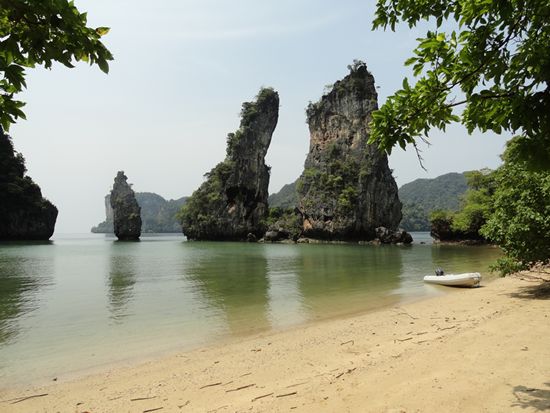Just Honging Around in Thailand

Peregrina's Journey
Peter and Margie Benziger
Sun 1 Apr 2012 14:57
Just “Hong”ing Around
in Phang Nga Bay
Peregrina is now cruising the Andaman Sea in a secluded area
called Phang Nga Bay, Thailand. This is a
155 square mile paradise bordered by Phuket Island to the southwest and two mainland
provinces: Phang Nga to the northwest
and Krabi on the northeast. As such, it’s
very protected which, luckily, allowed the 100+ islands in the bay to escape
the ravages of the 2004 Tsunami with minimal damage.
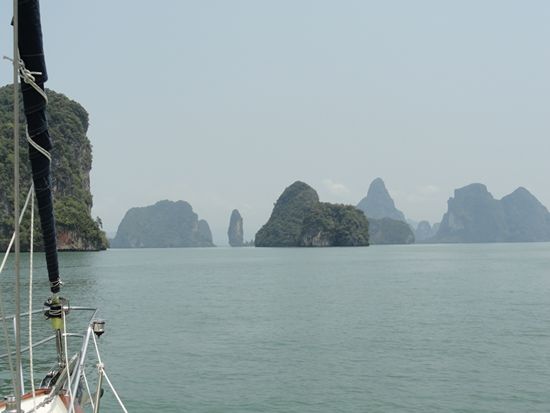
I should say, lucky for the rest of the world as well. Phang Nga Bay hosts some of Thailand’s most
spectacular scenery with its towering limestone islands, called “stacks”, rising
like sheer pinnacles from the shallow waters up to 1,150 feet high.
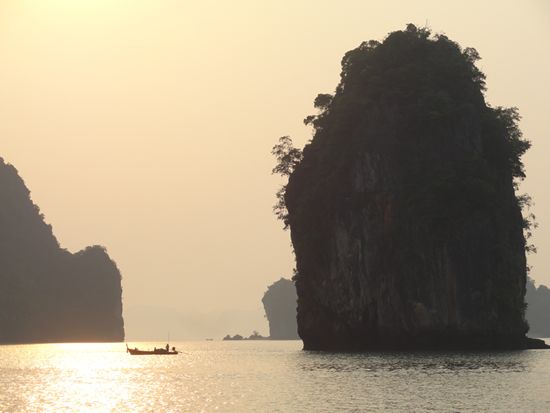
Let me explain a little about the origin of the stacks of
Phang Nga Bay. About 130 million years
ago, this area was underwater and part of a vast coral reef. Calcium deposits built up from coral in thick
layers which eventually turned into limestone.
75 million years ago, tectonic plate movement pushed the limestone up
out of the ocean. (Phang Nga is actually
a section of what was once the Tenasserim Mountains which formed a spine from
Thailand to China.)
20,000 years ago at the end of the last Ice Age, the sea
level rose again and the limestone was eroded by wave and tidal action.
Today, the sea in Phang Nga Bay is about 13 feet lower than
the highest level it reached 8,000 years ago and the limestone landscape we see
now is known by geologists as “drowned karstland.” Karst (the proper name for stacks) is
characterized by an internal drainage system which carries the water to the
interior of the limestone via fissures in the rock - thus eroding it from
within.
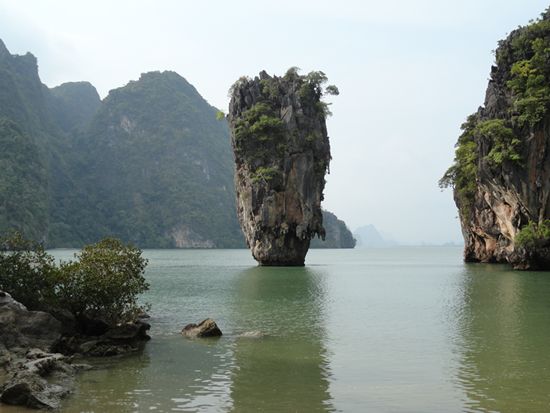
How does this happen?
Limestone is a porous, sedimentary rock and rain, when combined with
carbon dioxide in the air and the CO2 in the soil, dissolves the mineral
calcite which is the primary element in limestone.
The result is that these mountains had water percolating down through cracks
from the top as well as wave action eroding the sides.
Here
you can see the effect of the wave action eroding the base of the rocks..
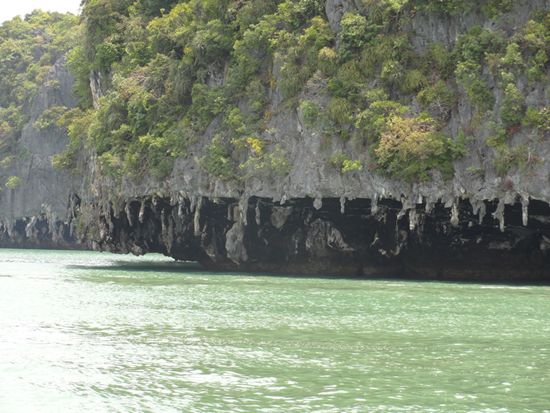
The rainwater hitting the top of the mountains
dissolves the limestone from the top and
the combination of the eroding base and
dissolving top often sends parts the island mountain chain crashing into the
sea – leaving what they now call stacks.
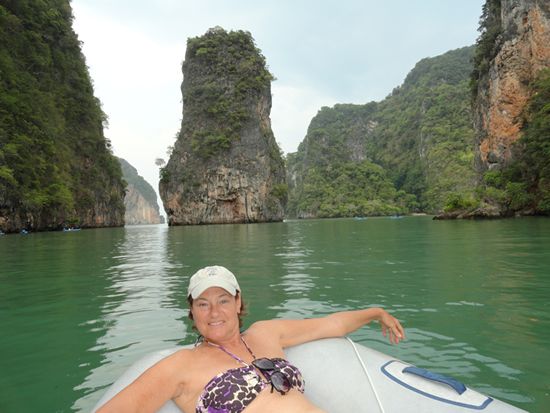
But, there’s more to this story! Sometimes the outside walls of the stacks
remain completely intact and only the limestone on the inside is hollowed out
right down to sea level. At the same
time, the action of the pounding waves erodes the stacks from the sea level side
forming narrow caves and tunnels which make their way into the center of the
stack. When the two hollows meet, the
center of the karst fills with water creating a “hong” which means “room” in
Thai. A hong is a virtual room inside a
stack and often these rooms have sheer walls hundreds of feet high extending to
the top of the stack. And the only way
in is through the cave tunnels.
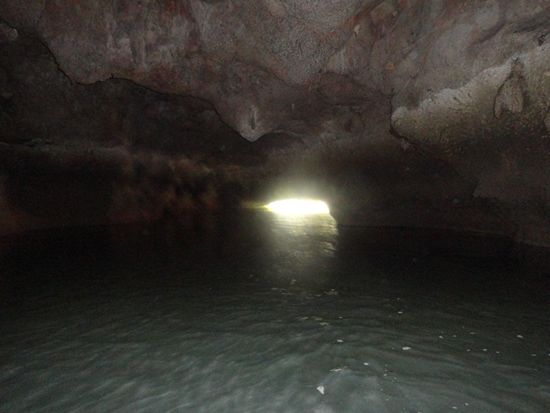
It is the world inside these hongs that Peter and I have
been exploring over the past three days by walking in, swimming in, kayaking or
taking our dingy through, dark tunnels into the sunlight of the hidden hong
inside.
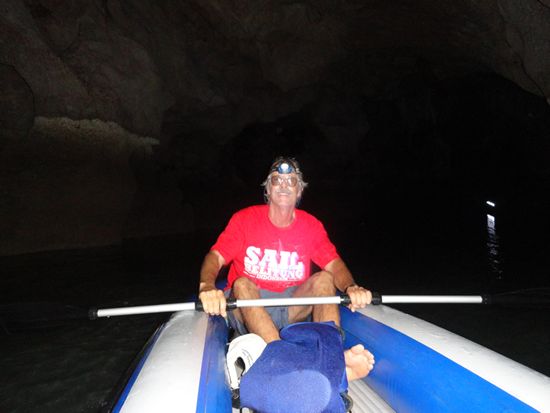
Finding the hongs of Phang Nga Bay is not always easy. The cave openings are often only recognizable
at low tide. We have to time our hong expeditions
carefully in order to get in and out before the “window of opportunity”
closes. It’s best to enter a hong
mid-way from dead low tide so that you have plenty of time before the rising
water closes off the entrance. In one hong,
we found that, when we wanted to get out, the rising tide had left only about two
feet of airspace between the water and the top of the cave tunnel. We went really quickly through the tunnel so
as not to get trapped for six hours as the tide changed. Did I mention that the cave tunnels often have
bats nesting and flying around?
Generally, they will stay pretty quiet but, when the tide rises and you
find yourself within an arm’s length of their nests, they can become
agitated. Thus, you have bats flying,
tide rising, not much air left….YIKES!!!
But, once inside the hong – coming out of the darkness and
into the light - it’s just magical.
Imagine a self-contained botanical garden/tropical lagoon surrounded 360
degrees by sheer cliffs that reach up through the roofless hollow to the
sunlight. It a mass of palms and ferns
and giant cycads and succulent plants all tangled and twisted and hanging
upside-down and sideways. Often, there
are little white sand beaches that appear with the low tide and disappear with
the high. It’s stuff we thought you
could only see in the movies or in your wildest dreams but here we are…so
blessed and grateful for this special day!
